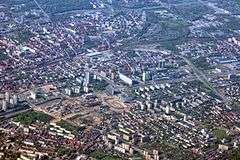Spodek
 The Spodek arena after facade renovation in 2011 | |
| Location | Katowice, Poland |
|---|---|
| Coordinates | 50°15′58″N 19°01′31″E / 50.26611°N 19.02528°ECoordinates: 50°15′58″N 19°01′31″E / 50.26611°N 19.02528°E |
| Capacity | 11,500 |
| Construction | |
| Broke ground | 1964 |
| Opened | 1971 |
| Tenants | |
|
Eurobasket 2009 2016 European Men's Handball Championship 2014 FIVB Volleyball Men's World Championship | |

Spodek (meaning "saucer" in Polish) is a multipurpose arena complex in Katowice, Poland, opened in 1971 at ul. Korfantego 35 under the name Wojewódzka Hala Widowiskowo-Sportowa w Katowicach (Voivodeship Sport and Show Arena in Katowice), under which it is known in the Polish technical/architectural literature, and under which it formally functioned until 1997.
Aside from the main dome, the complex includes a gym, an ice rink, a hotel and three large car parks. It was the largest indoor venue of its kind in Poland until it was surpassed by Kraków Arena in 2014. It hosts many important cultural and business events. Music concerts are especially common non-sport events. Spodek can hold 11,500 people, although this number is in practice limited to 10,000 or even 8,000 due to stage set-ups obscuring the view. Its Polish name refers to a flying saucer (its shape resembles a UFO). Spodek is a major contribution to the cultural significance of Katowice in Poland, especially for the younger generations. It has also been used as an unofficial logo for the city on posters promoting redevelopment in Katowice. Spodek is home to HC GKS Katowice ice hockey club in the winter months.
History
The idea of building a large venue originated in 1955, while Katowice was temporarily renamed Stalinogród. A contest was held to select the best design. Initially, it was to be constructed on the outskirts of town, but the Voivodeship National Council decided it should be built near the city center. A mining waste dump site classified "2A" was chosen for construction.
The classification "2A" indicated medium mining damage with a possibility of local cave-ins. While excavating the foundations, the workers dug through coal instead of soil. Soon after construction began, rumors of design flaws in the new building spread, including the rumour that the dome would collapse when the scaffolding was removed. Because of this, in 1964, construction was halted for 18 months. Spodek's architects and chief engineers entered the dome when the supports were dismantled as a response to those rumors; clearly they survived. Before opening the building to the public, endurance tests were conducted – 3,500 soldiers marched into the hall and vibration of the building was measured. The outcome was positive.
Throughout Spodek's history, rumors have circulated concerning the extent of disrepair at the structure, concealed cracks or even its "falling apart". However, these rumours are unsupported by any evidence.
Technology

Maciej Gintowt and Maciej Krasiński, architects of Spodek, designed the Spodek as one of the first major structures to employ the principle of tensegrity. The roof uses an inclined surface held in check by a system of cables holding up its circumference.
The structural engineer who conceived the unique tensegrity roof and made it work is Wacław Zalewski. His innovative structures include Supersam, a supermarket in Warsaw with a roof made up of alternating arches and cables, many unique industrial roofs in Poland, two basketball arenas in Venezuela with hanging roofs, the structure of the National Museum of Art in Caracas, the Venezuelan Pavilion at the Seville's Expo in 1992, and several bridges and roofs in South Korea.
Hosted events
- Electronic Sports League tournaments, including the Intel Extreme Masters World Championships beginning in 2014: EMS One Katowice 2014, ESL One Katowice 2015, IEM Season IX - Katowice, IEM Season X - Katowice
- Blaze Bayley (of Iron Maiden and Wolfsbane) recorded his Alive in Poland DVD at Spodek in 2007
- Deep Purple recorded their Live Encounters DVD at Spodek in 1996
- Pearl Jam recorded their 6/16/00 - Katowice, Poland album at Spodek
- Smashing Pumpkins cover photo (inside) for the album Adore was taken in Katowice after a concert in Spodek
- The band Hey recorded their 1994 Hey Live! album at Spodek.
- The arena held the final rounds of the EuroBasket 2009.[1]
- FIVB Volleyball World League Final Round 2001 & 2007
- EuroBasket Women 2011
- Intel Extreme Masters World Championship in 2014
- 2014 FIVB Volleyball Men's World Championship
- 2016 European Men's Handball Championship
- 2016 IIHF World Championship Division IA
- The WTA Tour BNP Paribas Katowice Open, a professional women's tennis tournament, is held at Spodek annually since 2013
See also
References
- ↑ Kibice wywalczyli nam polskie mecze, 15 January 2007
External links
| Wikimedia Commons has media related to Spodek. |
- Official website (in Polish)
- Aerial view of the complex and depictions and descriptions of its interior (in Polish)
- Pictures of its construction
- Aerial views
| Preceded by Scandinavium Gothenburg |
European Indoor Championships in Athletics Venue 1975 |
Succeeded by Olympiahalle Munich |
| Preceded by Ahoy Rotterdam Rotterdam |
FIVB Volleyball World League Final Venue 2001 |
Succeeded by Mineirinho Arena Belo Horizonte |
| Preceded by Luzhniki Small Sports Arena Moscow |
FIVB Volleyball World League Final Venue 2007 |
Succeeded by Ginásio do Maracanãzinho Rio de Janeiro |
| Preceded by Palacio de Deportes de la CAM Madrid |
FIBA EuroBasket Final Venue 2009 |
Succeeded by Žalgiris Arena Kaunas |
| Preceded by PalaLottomatica Rome |
FIVB Volleyball Men's World Championship Final Venue 2014 |
Succeeded by TBD |